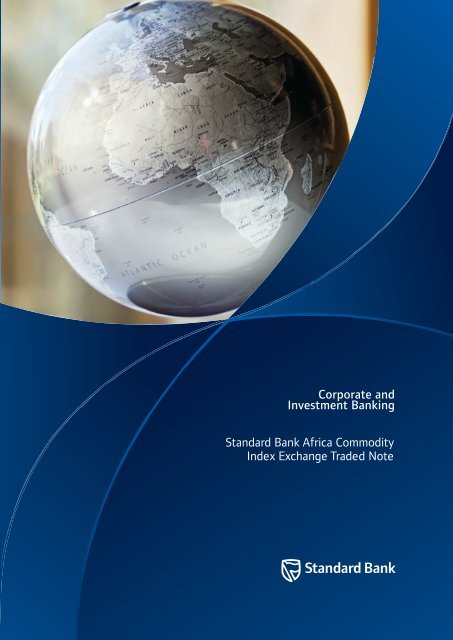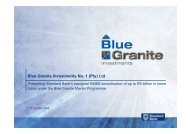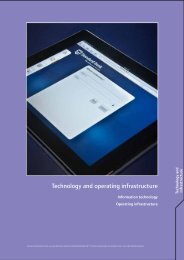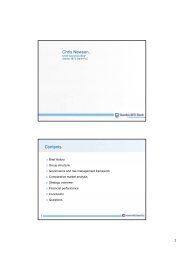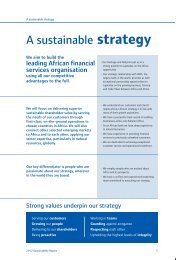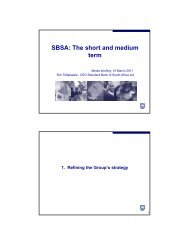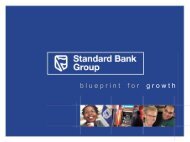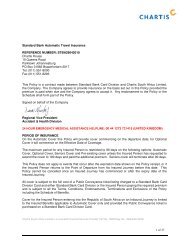Standard Bank Africa Commodity Index ETN brochure
Standard Bank Africa Commodity Index ETN brochure
Standard Bank Africa Commodity Index ETN brochure
Create successful ePaper yourself
Turn your PDF publications into a flip-book with our unique Google optimized e-Paper software.
Corporate and<br />
Investment <strong>Bank</strong>ing<br />
<strong>Standard</strong> <strong>Bank</strong> <strong>Africa</strong> <strong>Commodity</strong><br />
<strong>Index</strong> Exchange Traded Note
Introduction to Commodities<br />
as an Asset Class 2<br />
The <strong>Standard</strong> <strong>Bank</strong> <strong>Africa</strong><br />
<strong>Commodity</strong> <strong>Index</strong> 4<br />
<strong>Standard</strong> <strong>Bank</strong>’s Blue Access<br />
<strong>ETN</strong> Platform 6<br />
The <strong>Standard</strong> <strong>Bank</strong> <strong>Africa</strong><br />
<strong>Commodity</strong> <strong>Index</strong> <strong>ETN</strong> 6<br />
<strong>Africa</strong> <strong>Commodity</strong> <strong>Index</strong><br />
<strong>ETN</strong> General Specifications 8<br />
<strong>Africa</strong> <strong>Commodity</strong> <strong>Index</strong><br />
composition 10<br />
Simulated Historical performance 11<br />
SBAFCI Construction and<br />
Calculation Methodology 12
Introduction to Commodities<br />
as an Asset Class<br />
Commodities have been recognised in recent years as an asset<br />
class endowed with unique features and providing an interesting<br />
ingredient to a diversified financial portfolio. The principal<br />
benefits that may arise from adding commodity exposure to a<br />
portfolio are as follows:<br />
• <strong>Commodity</strong> markets trade globally, offering distinct<br />
advantages in liquidity and the free flow of commodity<br />
information.<br />
• <strong>Commodity</strong> returns generally exhibit negative correlation<br />
with returns from traditional asset classes such as equities<br />
and bonds.<br />
• Low or negative correlation across commodity sectors<br />
provides further diversification benefits.<br />
• <strong>Commodity</strong> returns are sometimes found to have a positive<br />
correlation with inflation hence providing a natural<br />
inflationary hedge.<br />
2
<strong>Standard</strong> <strong>Bank</strong> <strong>Africa</strong> <strong>Commodity</strong> <strong>Index</strong> Exchange Traded Note<br />
3
4<br />
The <strong>Standard</strong> <strong>Bank</strong> <strong>Africa</strong><br />
<strong>Commodity</strong> <strong>Index</strong> (SBAFCI)<br />
The SBAFCI is passive ZAR based index, and aims to reflect a<br />
diversified basket of commodities calculated on the basis of their<br />
average <strong>Africa</strong>n production value of the most recent five year<br />
period. To achieve more stable returns, commodity weights in<br />
the index are adjusted based on an aggregated risk measure of<br />
the commodity returns as outlined in the <strong>Index</strong> Rules Document.<br />
The weightings in the underlying commodities for the <strong>Index</strong><br />
are determined through the application of maximum and<br />
minimum weight thresholds to redistribute commodity weights;<br />
this ensures that no single commodity or commodity sector<br />
dominates the SBAFCI. The index thus invests in four recognised<br />
commodity sub-sectors which include Base Metals, Precious<br />
Metals, Energy and Agricultural. The respective underlying<br />
commodities at the time of issue are Aluminium and Copper,<br />
Gold and Platinum, Crude Oil, Corn and Wheat.<br />
The commodity weightings are revised annually as outlined<br />
in the <strong>Index</strong> Rules Document. The index constituents are<br />
rolled every two months into a more distant liquid contract as<br />
the near-dated future moves closer to expiry in terms of the<br />
agreed weighting across the set of future contracts that is set in<br />
accordance with the <strong>Index</strong> Rules Document.<br />
The SBAFCI is a total return index, created from the near-dated<br />
USD commodity future, USD interest rates and the USD/ZAR<br />
exchange rate. The near-dated future is used as it is typically the<br />
most cost effective way of gaining exposure to commodities; this<br />
is then rolled every two months into the next liquid contract as<br />
the near-dated futures move closer to expiry.<br />
As a total return index, the return is derived from the following<br />
four sources:<br />
1) Performance of the commodity future contracts: change in<br />
the near-dated future’s USD contract prices<br />
2) USD deposit rate that accrues daily on the full value of the<br />
investment: overnight USD Libor less 0.125%<br />
3) Change in USD/ZAR exchange rate<br />
4) Roll and rebalancing yield: a result from rolling the current<br />
future into a distant future due to an approaching expiry.<br />
The future positions will need to be rolled over into more distant<br />
contracts as the near dated contracts approach maturity. The<br />
rolling mechanism will begin 40 days prior to the expiry of any<br />
futures contract, with the position being rolled over a five-day<br />
period to reflect an average roll return. All futures contracts are<br />
pre-determined to ensure that only sufficiently liquid futures<br />
contracts are used.<br />
When rolling from one future to another the full rand value is<br />
rolled into the next future, therefore if the next future’s price<br />
is higher/lower than the near dated one, your exposure will<br />
decrease/increase such that a 1% change in the futures price<br />
still relates to a 1% change in the <strong>ETN</strong> price.<br />
The <strong>Index</strong> was created by The <strong>Standard</strong> <strong>Bank</strong> of South <strong>Africa</strong><br />
Limited (“<strong>Standard</strong> <strong>Bank</strong>”) and launched on 18 August 2011<br />
(the “<strong>Index</strong> Live Date”) and is published live on Bloomberg,<br />
<strong>Index</strong> code: SBAFCI.<br />
The <strong>Index</strong> Rules Document can be viewed on<br />
www.standardbank.co.za/etns
<strong>Standard</strong> <strong>Bank</strong> <strong>Africa</strong> <strong>Commodity</strong> <strong>Index</strong> Exchange Traded Note<br />
5
<strong>Standard</strong> <strong>Bank</strong>’s Blue Access<br />
<strong>ETN</strong> Platform<br />
In order to meet investor demand for access to new markets,<br />
<strong>Standard</strong> <strong>Bank</strong> has created the Blue Access <strong>ETN</strong> Platform.<br />
Blue Access operates through <strong>Standard</strong> <strong>Bank</strong>’s ZAR60 billion<br />
Domestic Medium Term Note (DMTN) Programme. This platform<br />
provides investors with a cost-effective opportunity to invest in<br />
hard-to- reach markets through a local exchange.<br />
<strong>ETN</strong>s are JSE Limited (“JSE”) instruments that track the<br />
performance of an underlying instrument or index. These <strong>ETN</strong>s<br />
provide investors with a vehicle to access a market previously<br />
inaccessible to both individual and institutional South <strong>Africa</strong>n<br />
investors. <strong>Standard</strong> <strong>Bank</strong> is the issuer and market maker of the<br />
notes and therefore facilitate the buying and selling of <strong>ETN</strong><br />
positions thus ensuring the liquidity. <strong>Standard</strong> <strong>Bank</strong> <strong>ETN</strong>s will<br />
constitute senior unsecured unsubordinated obligations.<br />
<strong>Standard</strong> <strong>Bank</strong> currently offers the following <strong>ETN</strong>’s off its Blue<br />
Access <strong>ETN</strong> Platform:<br />
Gold <strong>ETN</strong> – SBAG1<br />
Platinum <strong>ETN</strong> – SBAPL1<br />
Corn <strong>ETN</strong> – SBACRN<br />
Oil <strong>ETN</strong> – SBAOIL<br />
<strong>Africa</strong> Equity <strong>Index</strong> <strong>ETN</strong> – SBAEI<br />
<strong>Africa</strong> <strong>Commodity</strong> <strong>Index</strong> <strong>ETN</strong> – SBACI<br />
Silver <strong>ETN</strong> – SBAS1<br />
Palladium <strong>ETN</strong> – SBPD1<br />
Wheat <strong>ETN</strong> – SBAWHT<br />
Copper <strong>ETN</strong> – SBACOP<br />
The <strong>Standard</strong> <strong>Bank</strong> <strong>Africa</strong><br />
<strong>Commodity</strong> <strong>Index</strong> <strong>ETN</strong><br />
(SBACI)<br />
<strong>Standard</strong> <strong>Bank</strong>’s <strong>Africa</strong> <strong>Commodity</strong> <strong>Index</strong> Exchange Traded<br />
Note (“SBACI”) provides investors with a rand denominated<br />
security to directly access the <strong>Standard</strong> <strong>Bank</strong> <strong>Africa</strong> <strong>Commodity</strong><br />
<strong>Index</strong>, with no tracking error. The SBACI is listed on the JSE<br />
main board, off <strong>Standard</strong> <strong>Bank</strong>s existing Blue Access platform.<br />
Investors buy and sell the SBACI like any other equity over the<br />
exchange with <strong>Standard</strong> <strong>Bank</strong> acting as market maker thereby<br />
providing liquidity.<br />
The SBACI return is derived from the following two sources:<br />
1) Performance of the SBAFCI<br />
2) Annual management fee of 50bps accrued daily.<br />
6
<strong>Standard</strong> <strong>Bank</strong> <strong>Africa</strong> <strong>Commodity</strong> <strong>Index</strong> Exchange Traded Note<br />
7
<strong>Africa</strong> <strong>Commodity</strong> <strong>Index</strong> <strong>ETN</strong><br />
General Specifications<br />
Listing:<br />
The <strong>ETN</strong> is listed on the JSE under the <strong>ETN</strong> sub-sector.<br />
Trading:<br />
SBACI can be bought and sold through any JSE-approved member.<br />
Issuer and issuer credit rating:<br />
The <strong>ETN</strong>s are issued by <strong>Standard</strong> <strong>Bank</strong> off its Blue Access<br />
platform or ZAR60 Billon Domestic Medium Term Note (DMTN)<br />
Programme. <strong>Standard</strong> <strong>Bank</strong>’s credit rating is AA (ZAF) (Fitch<br />
Ratings: national rating for <strong>Standard</strong> <strong>Bank</strong> of South <strong>Africa</strong> as at<br />
10 August 2011). This is the credit risk the investor is exposed<br />
to when purchasing the SBACI.<br />
ACI <strong>ETN</strong> purchase price:<br />
Each SBACI will be issued at a price of about R10 which equals<br />
1/10th of the <strong>Index</strong>.<br />
Liquidity and secondary market:<br />
<strong>Standard</strong> <strong>Bank</strong> acts as the market maker and provides live<br />
intraday buy-and-sell prices on the JSE’s equity trading platform<br />
between 9:10 and 16:49 (live prices are not provided in the<br />
opening and closing auction period).<br />
Trading times:<br />
JSE trading times are 9:10 to 16:49.<br />
Cost of trading:<br />
An annual discount rate of 0.50 percent is charged. <strong>Standard</strong><br />
<strong>Bank</strong> also charges market related spreads between buy and<br />
sell prices.<br />
Term:<br />
The term of the notes is 10 years. Investors wishing to sell their<br />
notes prior to maturity can do so in the secondary market.<br />
Performance:<br />
The performance of the SBACI is the underlying SBAFCI<br />
performance multiplied by the USD/ZAR exchange rate. The<br />
<strong>Africa</strong>n <strong>Commodity</strong> <strong>Index</strong> is available on Bloomberg under the<br />
ticker SBAFCI .<br />
Exchange Control Rulings:<br />
For individual and corporate South <strong>Africa</strong>n Investors investing in<br />
the <strong>ETN</strong> there will be no impact on their foreign allocation limits.<br />
For institutional investors investing in the <strong>ETN</strong> usage of their<br />
applicable prudential limit would be required.<br />
8
<strong>Standard</strong> <strong>Bank</strong> <strong>Africa</strong> <strong>Commodity</strong> <strong>Index</strong> Exchange Traded Note<br />
9
<strong>Standard</strong> <strong>Bank</strong> <strong>Africa</strong><br />
<strong>Commodity</strong> <strong>Index</strong><br />
Composition<br />
The SBAFCI offers investors exposure to a basket of<br />
commodities, weighted in accordance to their <strong>Africa</strong> production<br />
in the last five years. Based on the current composition as of<br />
18 August 2011, the SBAFCI has the following constituents:<br />
<strong>Commodity</strong> Sector Weights<br />
33.63%<br />
20.10%<br />
10.10%<br />
Precious metals<br />
Base metals<br />
Agriculture<br />
36.16%<br />
Energy<br />
<strong>Commodity</strong> Weights<br />
14.44%<br />
8.85%<br />
11.26%<br />
5.00%<br />
5.10%<br />
Gold<br />
Platinum<br />
Copper<br />
Aluminium<br />
19.19%<br />
36.16%<br />
Corn<br />
Wheat<br />
WTI-Oil<br />
10
<strong>Standard</strong> <strong>Bank</strong> <strong>Africa</strong> <strong>Commodity</strong> <strong>Index</strong> Exchange Traded Note<br />
Simulated Historical Performance<br />
<strong>Africa</strong> <strong>Commodity</strong> <strong>Index</strong> performance against other South <strong>Africa</strong>n asset class indices dated from 1 August 2000 to 1 June 2011<br />
7000.00<br />
6000.00<br />
5000.00<br />
CPI<br />
ALBI<br />
TOP 40<br />
SBAFCI<br />
4000.00<br />
3000.00<br />
2000.00<br />
1000.00<br />
0.00<br />
01 Aug 00<br />
01 Dec 00<br />
01 Apr 01<br />
01 Aug 01<br />
01 Dec 01<br />
01 Apr 02<br />
01 Aug 02<br />
01 Dec 02<br />
01 Apr 03<br />
01 Aug 03<br />
01 Dec 03<br />
01 Apr 04<br />
01 Aug 04<br />
01 Dec 04<br />
01 Apr 05<br />
01 Aug 05<br />
01 Dec 05<br />
01 Apr 06<br />
01 Aug 06<br />
01 Dec 06<br />
01 Apr 07<br />
01 Aug 07<br />
01 Dec 07<br />
01 Apr 08<br />
01 Aug 08<br />
01 Dec 08<br />
01 Apr 09<br />
01 Aug 09<br />
01 Dec 09<br />
01 Apr 10<br />
01 Aug 10<br />
01 Dec 10<br />
01 Apr 11<br />
Source: The <strong>Standard</strong> <strong>Bank</strong> of South <strong>Africa</strong> Limited, Research<br />
Correlation of South <strong>Africa</strong> CPI against other market accepted indices<br />
y/y<br />
S&P Goldman<br />
Sachs<br />
Reuters/Jefferies Dow Jones UBS Morningstar<br />
Long/Short<br />
Deutsche <strong>Bank</strong><br />
<strong>Standard</strong> <strong>Bank</strong><br />
CPI(+3) 0.26 0.32 0.3 0.42 0.36 0.45<br />
CPI(+6) 0.25 0.35 0.39 0.49 0.4 0.5<br />
11
SBAFCI Construction and<br />
Calculation Methodology<br />
The SBAFCI is constructed on the basis of a set of rigid and<br />
transparent procedures, a summary of which is given below.<br />
For a more in depth description of the SBAFCI calculation<br />
methodology, please refer to the <strong>Index</strong> Rules document on the<br />
<strong>Standard</strong> <strong>Bank</strong> website (refer to contact details).<br />
The SBAFCI embodies four main principles in its design:<br />
• Simplicity and Transparency<br />
The overarching principle in the conception of the SBAFCI<br />
is simplicity and transparency in it’s construction and<br />
methodology, whilst maintaining a balanced representation<br />
of commodity trends in <strong>Africa</strong>n production. A restricted set of<br />
commodity futures contracts allows for easy and transparent<br />
analysis of the impact of specific commodity sectors on the<br />
value of the SBAFCI. On top of it, a rolling methodology is<br />
applied focusing on those contract months with a high degree<br />
of liquidity, which aims to minimise the transaction costs of<br />
replicating the <strong>Index</strong>. Moreover, all commodities included in<br />
this index must be publicly traded on exchanges to ensure<br />
ease of tracking and verification. If a commodity trades on<br />
more than one exchange, the most liquid contract, in terms<br />
of trading volume and open interest combined, is selected.<br />
• Economic Significance<br />
The <strong>Index</strong> intends to fairly represent a diversified group of<br />
commodities in the <strong>Africa</strong>n economy. For a commodity to be<br />
included in the <strong>Index</strong>, it needs to play a significant role in<br />
<strong>Africa</strong>n production.<br />
• Continuity<br />
The <strong>Index</strong> intends to be responsive to the changing nature<br />
of <strong>Africa</strong>n commodity markets in a manner that does not<br />
completely reshape the character of the <strong>Index</strong> from year to<br />
year. It is intended to provide a stable benchmark, so that<br />
users of the <strong>Index</strong> may be reasonably confident that historical<br />
performance data is based on a structure that bears some<br />
resemblance to both the current and future composition<br />
of the <strong>Index</strong>. This objective is supported by a conservative<br />
selection/rebalancing process and the diversification rules.<br />
• Diversification and Stability<br />
Disproportionate weighting of any particular single commodity<br />
or commodity sector increases risk and negates the concept<br />
of a broad-based and representative <strong>Index</strong>. Another goal<br />
of the <strong>Index</strong> is to provide diversified and stable exposure to<br />
commodities as an asset class. The following diversification<br />
rules have been established and are enforced every two<br />
calendar months, each time the <strong>Index</strong> is rolled and rebalanced:<br />
– Neither Single <strong>Commodity</strong> nor <strong>Commodity</strong> Sector may<br />
constitute less than 5% of the <strong>Index</strong>.<br />
– Neither Single <strong>Commodity</strong> nor <strong>Commodity</strong> Sector may<br />
constitute more than 40% of the <strong>Index</strong>.<br />
In addition, specific weighting techniques are applied to those<br />
commodities which demonstrate a certain risk profile in order to<br />
target more stable returns.<br />
12
<strong>Standard</strong> <strong>Bank</strong> <strong>Africa</strong> <strong>Commodity</strong> <strong>Index</strong> Exchange Traded Note<br />
13
Description of the SBAFCI<br />
The <strong>Index</strong> is a long only broad-based commodity index with<br />
exposure to four <strong>Commodity</strong> Sectors.<br />
The <strong>Index</strong> invests in seven USD denominated commodity futures<br />
(listed in separate exchanges).<br />
All together the <strong>Index</strong> <strong>Commodity</strong> Basket is denominated in USD<br />
however converted to ZAR on Each <strong>Index</strong> Calculation Date.<br />
The following is a product profile of the Single Commodities<br />
(denominated in USD) included in the <strong>Index</strong> <strong>Commodity</strong> Basket,<br />
as per the date of issue of this document:<br />
Product profile of commodity futures<br />
i<br />
Single <strong>Commodity</strong> Sector Root Symbol<br />
<strong>Commodity</strong> i<br />
1 LME Aluminum Base Metal LA<br />
2 LME Copper Base Metal LP<br />
3 NYMEX WTI Energy<br />
CL<br />
Crude Oil<br />
4 COMEX Gold Precious Metal GC<br />
5 NYMEX Platinum Precious Metal PL<br />
6 CBT Corn Agricultural C<br />
7 CBT Wheat Agricultural W<br />
Rolling and Rebalancing<br />
The <strong>Index</strong> is rolled and rebalanced every two calendar months.<br />
Each <strong>Index</strong> Roll happens over a period of five consecutive <strong>Index</strong><br />
Calculation Dates, starting on the first <strong>Index</strong> Calculation Date of<br />
the <strong>Index</strong> Roll months, February, April, June, August, October<br />
and December.<br />
During a Roll Period, the <strong>Index</strong> replicates positions in new<br />
futures contracts based on Contract Roll Weights and on the<br />
basis of new Adjusted Contract Productions Weights calculated<br />
on the corresponding <strong>Index</strong> Rebalancing Date.<br />
On <strong>Index</strong> Roll Dates, the <strong>Index</strong> replicates reverse positions in<br />
the existing contracts (that is, contracts with shortest term to<br />
expiry) and positions in new contracts (i.e. contracts with second<br />
shortest term to expiry).<br />
Contract Roll Weight<br />
The following table shows Contract Roll Weights (that is, for<br />
each Single <strong>Commodity</strong> i, the weights associated to the existing<br />
contracts and the new contracts on each <strong>Index</strong> Roll Date) during<br />
a Roll Period:<br />
Contract Roll Weights (CRWs) in a Roll Period<br />
<strong>Index</strong><br />
Roll<br />
Date<br />
CRW for contracts<br />
with shortest term to<br />
expiry (CRW<br />
L<br />
t)<br />
CRW for contracts with<br />
second shortest term<br />
to expiry (CRW<br />
N<br />
t<br />
)<br />
1 0.8 0.2<br />
2 0.6 0.4<br />
3 0.4 0.6<br />
4 0.2 0.8<br />
5 0.0 1.0<br />
Note: CRW<br />
N<br />
=1 – CRW<br />
L<br />
t<br />
t<br />
Roll Calendar<br />
For each Single <strong>Commodity</strong> and each <strong>Index</strong> Roll Month, the<br />
following table provides the list of the contracts in which new<br />
positions are initiated:<br />
Roll Calendar<br />
Single<br />
<strong>Commodity</strong><br />
i i/<strong>Index</strong><br />
Feb Apr Jun Aug Oct Dec<br />
Roll Month<br />
1 LME May Jul Sep Nov Jan Mar<br />
Aluminum<br />
2 LME Copper May Jul Sep Nov Jan Mar<br />
3 NYMEX WTI May Jul Sep Nov Jan Mar<br />
Crude Oil<br />
4 COMEX Jun Aug Dec Dec Feb Apr<br />
Gold<br />
5 NYMEX Jul Jul Oct Jan Jan Apr<br />
Platinum<br />
6 CBT Corn Jul Jul Sep Dec Mar Mar<br />
7 CBT Wheat Jul Jul Sep Dec Mar Mar<br />
Rebalancing Schedule<br />
The Rebalancing Schedule coincides with the Roll Schedule.<br />
Rebalancing Period<br />
Each Rebalancing Period reflects the period between two <strong>Index</strong><br />
Rebalancing Dates.<br />
14
<strong>Standard</strong> <strong>Bank</strong> <strong>Africa</strong> <strong>Commodity</strong> <strong>Index</strong> Exchange Traded Note<br />
15
Contact Details<br />
For product information:<br />
Contact <strong>Standard</strong> <strong>Bank</strong> on <strong>ETN</strong>S@standardbank.co.za or<br />
+27 (0) 800 111 780<br />
Visit us at www.standardbank.co.za/etns or www.warrants.co.za<br />
To register for trade:<br />
Log on to Online Share Trading at<br />
https://securities.standardbank.co.za to start building your<br />
own <strong>ETN</strong> portfolio or contact your JSE-approved stockbroker<br />
or financial advisor.<br />
Disclaimer<br />
This document is provided on the express understanding that the<br />
information contained herein would be regarded and treated as<br />
strictly confidential and proprietary to The <strong>Standard</strong> <strong>Bank</strong> of South<br />
<strong>Africa</strong> Limited acting through its Corporate and Investment <strong>Bank</strong>ing<br />
Division (“SBSA”), the <strong>Standard</strong> <strong>Bank</strong> Group Limited and its subsidiaries<br />
(collectively “<strong>Standard</strong> <strong>Bank</strong> Group”). It is not to be delivered nor shall<br />
its contents be disclosed to anyone other than the entity to which it is<br />
being provided and its employees. Moreover, it shall not be reproduced<br />
or used, in whole or in part, for any purpose other than for the<br />
consideration of the information set out herein, without the prior written<br />
consent of SBSA or the <strong>Standard</strong> <strong>Bank</strong> Group as appropriate.<br />
This document has also been prepared solely for information purposes<br />
by SBSA. Any indicative terms provided to you are provided for your<br />
information and do not constitute an offer, a solicitation of an offer,<br />
invitation to acquire any security or to enter into any agreement, or any<br />
advice or recommendation to conclude any transaction (whether on the<br />
indicative terms or otherwise) and must not be deemed as such.<br />
Any information, indicative price quotations, disclosure materials or<br />
analyses provided to you have been prepared on assumptions and<br />
parameters that reflect good faith determinations by SBSA or that have<br />
been expressly specified by you and do not constitute advice by SBSA<br />
and it should not be relied upon as such. The information, assumptions<br />
and parameters used are not the only ones that might reasonably have<br />
been selected and therefore no guarantee is given as to the accuracy,<br />
completeness, or reasonableness of any such information, quotations,<br />
disclosure or analyses. No representation or warranty is made that any<br />
indicative performance or return indicated will be achieved in the future.<br />
This document is not an official confirmation of terms, does not<br />
represent an express or implied offer, nor does it create any liability<br />
or obligation on SBSA or the <strong>Standard</strong> <strong>Bank</strong> Group. Any rates, levels<br />
and prices quoted herein are indicative only and although reflective<br />
of market conditions prevailing at the relevant time do not constitute<br />
an offer to transact at such levels and are supplied for illustrative<br />
purposes only. Any transaction that may be concluded pursuant to<br />
this document shall be in terms of and confirmed by the signing of<br />
appropriate documentation, on terms to be agreed between the parties.<br />
The information in the document is also subject to change without<br />
notice. SBSA, the <strong>Standard</strong> <strong>Bank</strong> Group or an associated company, may<br />
have effected or may effect transactions for its own account in any<br />
investment outlined in the document or any investment related to such<br />
an investment. Prospective investors should obtain independent advice<br />
in respect of any product detailed in this document, as SBSA provides<br />
no opinion or advice including without limitation investment, tax or legal<br />
advice and makes no representation or warranty about the suitability of a<br />
product for a particular client or circumstance. Such independent advice<br />
should be sought subject to SBSA’s prior written consent. Transactions<br />
described in this material may give rise to substantial risk and are not<br />
suitable for all investors. SBSA will only provide investment advice if<br />
specifically agreed to by SBSA in appropriate documentation, signed by<br />
SBSA. This information is to be used at your own risk, and neither SBSA<br />
nor <strong>Standard</strong> <strong>Bank</strong> Group makes any representation with regards to the<br />
correctness of the information herein.<br />
16 SBSA 94915 – 8/11


